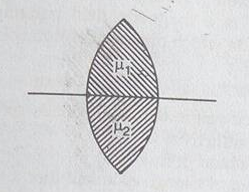Cosmic rays comes from
Sun
Other planets or outer space
Stratosphere
Both A and B
The correct Answer is:D
Step-by-Step Solution:
1. Understanding Cosmic Rays: Cosmic rays are high-energy particles that travel through space. They primarily consist of protons and atomic nuclei.
2. Identifying Sources of Cosmic Rays: The question asks where cosmic rays originate. The potential sources listed are:
- The Sun
- Other planets
- Outer space
- The stratosphere
- Both A and B (the Sun and other planets)
3. Evaluating Each Option:
- Sun: The Sun emits solar wind, which is a stream of charged particles, including protons. This contributes to cosmic rays.
- Other Planets: Other planets in our solar system can also emit particles, but they are not significant sources of cosmic rays compared to the Sun.
- Outer Space: Cosmic rays are indeed found in outer space, but they originate from various sources, including supernovae and other high-energy astrophysical processes.
- Stratosphere: The stratosphere is part of Earth's atmosphere and does not produce cosmic rays; rather, it is where cosmic rays can interact with the atmosphere.
- Both A and B: This option suggests that both the Sun and other planets contribute to cosmic rays.
4. Conclusion: The most accurate answer is that cosmic rays primarily come from outer space, with significant contributions from the Sun. However, since the question includes the option of both the Sun and other planets, the best choice is "Both A and B".
Final Answer: Cosmic rays come from both the Sun and other planets.
---
- The Sun
- Other planets
- Outer space
- The stratosphere
- Both A and B (the Sun and other planets)
- Sun: The Sun emits solar wind, which is a stream of charged particles, including protons. This contributes to cosmic rays.
- Other Planets: Other planets in our solar system can also emit particles, but they are not significant sources of cosmic rays compared to the Sun.
- Outer Space: Cosmic rays are indeed found in outer space, but they originate from various sources, including supernovae and other high-energy astrophysical processes.
- Stratosphere: The stratosphere is part of Earth's atmosphere and does not produce cosmic rays; rather, it is where cosmic rays can interact with the atmosphere.
- Both A and B: This option suggests that both the Sun and other planets contribute to cosmic rays.
Topper's Solved these Questions
- ENVIRONMENTAL ISSUESBOOK - CENGAGE BIOLOGYCHAPTER - ENVIRONMENTAL ISSUESEXERCISE - OLYMPIAD AND NTSE LEVEL EXERCISES
9 Videos
- ENVIRONMENTAL ISSUESBOOK - CENGAGE BIOLOGYCHAPTER - ENVIRONMENTAL ISSUESEXERCISE - CHALLENGING EXERCISE
3 Videos
- ENVIRONMENTAL ISSUESBOOK - CENGAGE BIOLOGYCHAPTER - ENVIRONMENTAL ISSUESEXERCISE - CONSOLIDATED EXERCISE
8 Videos
- CO-ORDINATION THROUGH HORMONES : ENDROCRINCE SYSTEMBOOK - CENGAGE BIOLOGYCHAPTER - CO-ORDINATION THROUGH HORMONES : ENDROCRINCE SYSTEMEXERCISE - CHALLENGING EXERCISE
3 Videos
- EVOLUTIONBOOK - CENGAGE BIOLOGYCHAPTER - EVOLUTIONEXERCISE - CHALLENGING EXERCISE
5 Videos
Similar Questions
The most energetic proton ever detected in the cosmic rays coming to Earth from space had an astounding kinetic energy of 3.0×1020eV (enough energy to warm a teaspoon of water by a few degrees).
How long does the trip take as measured in the reference frame of the proton?
View SolutionThe most energetic proton ever detected in the cosmic rays coming to Earth from space had an astounding kinetic energy of 3.0×1020eV (enough energy to warm a teaspoon of water by a few degrees).
Suppose that the proton travels along a diameter of the Milky Way galaxy (9.8×104ly). Approximately how long does the proton take to travel that diameter as measured from the common reference frame of Earth and the Galaxy?
View Solution
Knowledge Check
Sago comes from
ACalamus ritungBMetroxylon rumphiiCAreca catechuDPhoenix dactylifera.A: The electrical. Conductivity of the Earth's atmosphere does not change with altitude.
R : Cosmic rays from outer space entering the earth's atmosphere do not affect it.AIf both Assertion & Reason are true and the reason is the correct explanation of the assertion, then mark (1)BIf both Assertion & Reason are true but the reason is not the correct explanation of the assertion, then mark (2)CIf assertion is true statement but Reason is false, then mark (3)DIf both Assertion and Reason are false statements, then mark (4)Which of the following is true for rays coming from infinity ?
 ATwo images are formedBContinuous image is formed between focal points of upper and lower lensCOne image is formedDNone of the above
ATwo images are formedBContinuous image is formed between focal points of upper and lower lensCOne image is formedDNone of the above
The most energetic proton ever detected in the cosmic rays coming to Earth from space had an astounding kinetic energy of 3.0×1020eV (enough energy to warm a teaspoon of water by a few degrees).
What were the proton's Lorentz factor γ and speed v (both relative to the ground-based detector)?
View SolutionThe mean lifetime of stationary muons is measured to be 2.2000 μs. The mean lifetime of high-speed muons in a burst of cosmic rays observed from Earth is measured to be 20.000 μs. To five significant figures, what is the speed parameter β of these cosmic-ray muons relative to Earth?
View SolutionCutoff wavelength of X-rays coming from a Coolidge tube depends on the
View SolutionWhich of the following is true for rays coming from infinity ?

View SolutionConsider a photon of continuous X-ray coming from a Coolidge tube. Its energy comes from
View Solution
